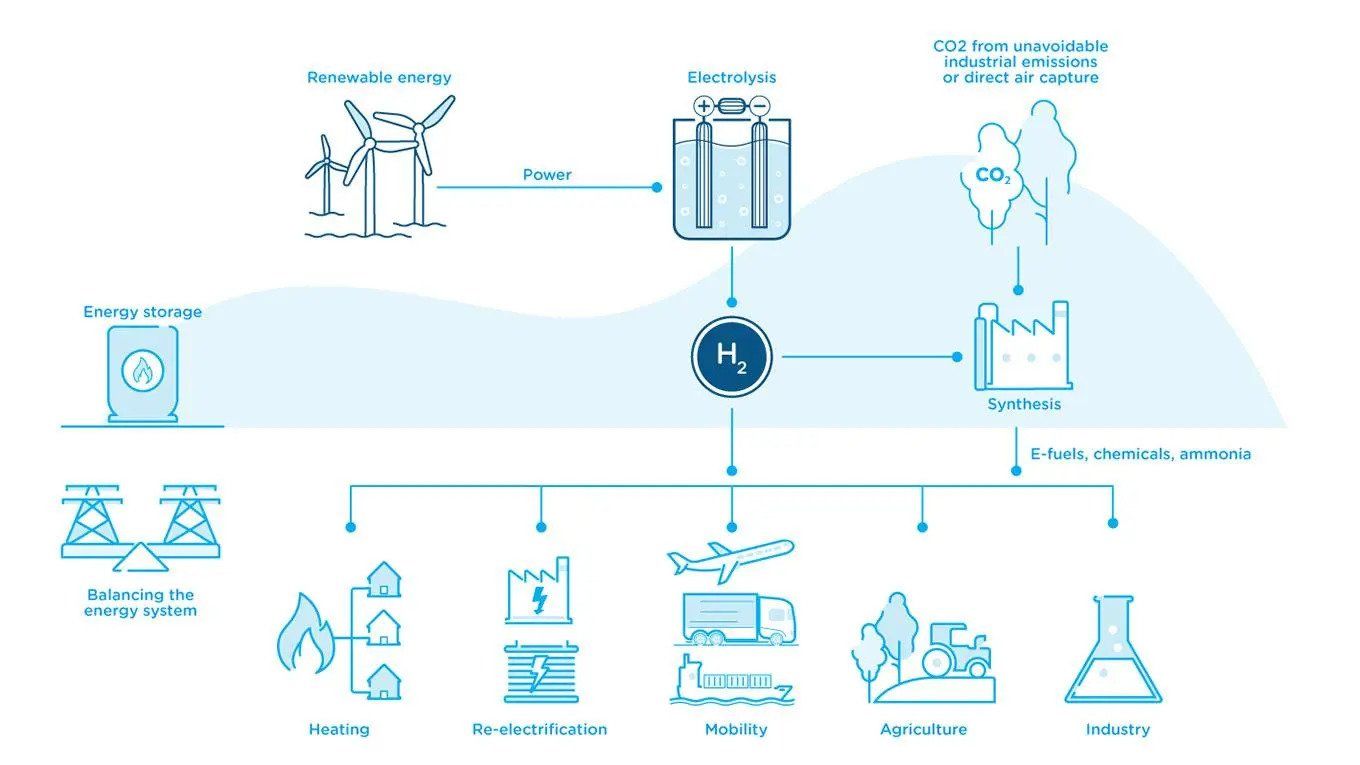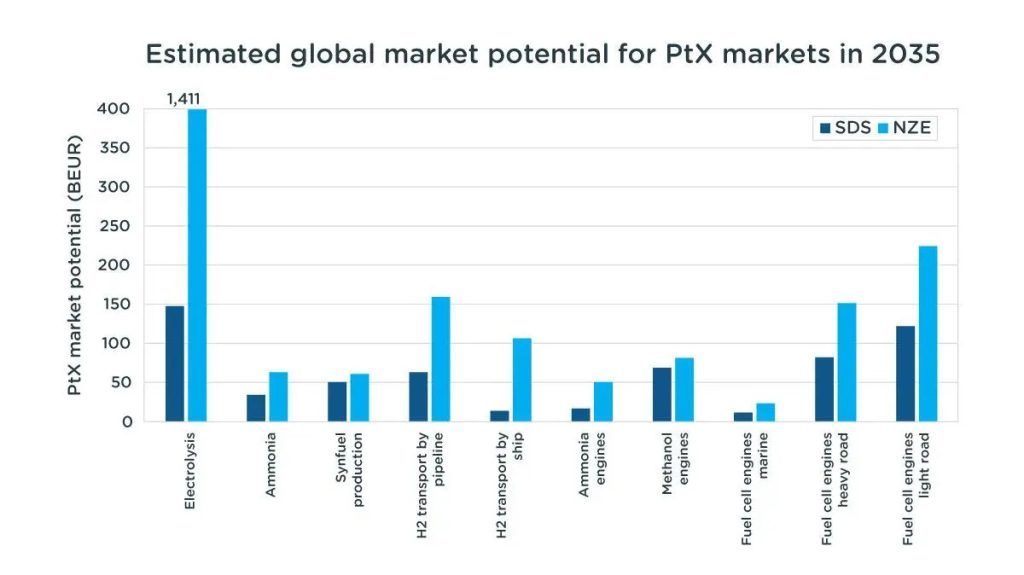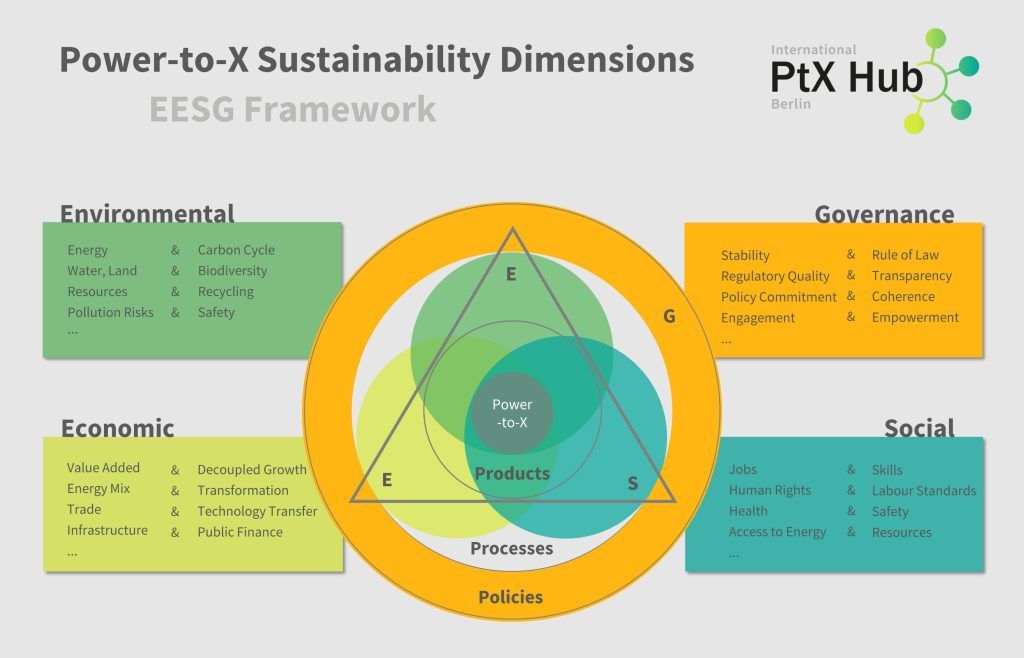
The Power-to-X technology has emerged as a key solution in the quest for decarbonization and energy transition. It encompasses various processes that convert surplus renewable energy into different forms of energy carriers, such as hydrogen, synthetic fuels, or chemicals. This article explores the impact of Power-to-X on European markets, highlighting its potential to revolutionize energy systems and address key challenges related to renewable energy integration and carbon emissions reduction.
Many processes are available today to produce green hydrogen, the main energy carrier when talking about Power-to-X. The most researched and available to use on the market at this moment is electrolysis. Electrolysis is the process of splitting water into its constituent elements, which are oxygen (O2) and of course hydrogen (H2). This technique uses a very simple chemical reaction where electrical energy is passed through an anode and a cathode (put more simply, the + and – of a battery cell) which are both submerged in an electrolyte (usually salt water). The electrical current passing through this electrolyte will cause it to split into hydrogen and oxygen gases. This resulting hydrogen is then purified, compressed and then stored for later use. Not only can it be compressed into gas cylinders, it can also be liquified or stored as a component in chemical compounds called metal hydrides. Compared to wind power generation which has an efficiency between 20 and 40%, electrolysis has an average efficiency of 80%. Just as there are many ways of producing it, hydrogen can be used in many industries thanks to its versatile form.

Figure 1: Hydrogen applications from electrolysis production (www.ramboll.com/net-zero-explorers/power-to-x-explained)
As Europe strives to achieve its ambitious climate goals, the integration of renewable energy sources into existing energy grids poses significant challenges. The intermittent nature of renewable energy generation and the lack of energy storage infrastructure hinder the efficient utilization of these clean energy sources. Power-to-X technologies offer a promising solution by allowing excess renewable energy to be converted, stored, and utilized when needed. However, the widespread adoption of Power-to-X and its implications on European markets warrant a deeper analysis.
Grid Stabilization and Energy Storage
One of the critical benefits of Power-to-X technologies is their ability to contribute to grid stabilization and energy storage. The intermittent nature of renewable energy sources, such as wind and solar, creates challenges in matching energy supply with demand. This means that the more we inject renewable energies in the grid, the more we will need to add storage capacity in order to use this renewable power throughout every hour of the day, and not only when renewable sources are able to produce. As of today, batteries are gaining in efficiency and longevity, but they cannot be scaled to utility level and at the same time be economically viable. Power-to-X offers a way to convert surplus renewable energy into hydrogen, which can be stored and used during periods of high demand or low renewable energy generation. This helps address the intermittency issue and ensures a reliable energy supply, enhancing grid stability. More than the intermittency issue, hydrogen can have an important impact of load balancing in periods of high demand. When used in fuel cells, hydrogen can be rapidly deployed (a few seconds) to inject power in the grid and make supply meet demand. Hydrogen fuel cells could then be used as a primary control reserve also called frequency containment reserve (FCR) which are the first response to frequency disturbances in the grid which create instability. Using the same logic, hydrogen could also increase grid resilience by giving an alternative power source to maintain critical infrastructure or provide electricity to isolated areas during emergencies and power outages.
Sector Coupling and Carbon Neutrality
Power-to-X enables the coupling of different sectors, such as power, transportation, and industry, by providing versatile energy carriers. For example, hydrogen produced through Power-to-X processes can be used in fuel cells to power vehicles or in industrial processes as a cleaner alternative to fossil fuels. By utilizing Power-to-X solutions, sectors traditionally reliant on fossil fuels can transition to low-carbon alternatives, contributing to carbon neutrality objectives and reducing greenhouse gas emissions. This integration of sectors paves the way for a more integrated and sustainable energy system. The global hydrogen powered transport market is growing at a rate never seen before: its value increased by more than 55% from 2022 to 2023, jumping from $5.15 billion to $8.17 billion. This compound annual growth rate (CAGR), which is no more than the speed at which the market is growing, is promised to keep this trend up until 2027, reaching a value of more than $50 billion.
Economic Opportunities
The widespread deployment of Power-to-X technologies can create new economic opportunities across the value chain. Research and development, manufacturing, installation, and maintenance of Power-to-X infrastructure all contribute to new opportunities. European countries investing in Power-to-X infrastructure can position themselves as leaders in this emerging sector, attracting investments and stimulating economic growth. The growth of the Power-to-X industry can also foster a competitive advantage for European companies in the global market. Market potentials for different usage show an important growth, and as stated before, electrolysis will play the most important role. Estimations were made by the IEA to calculate the global market potentials in 2035 for different Power-to-X technologies considering two different scenarios: the Sustainable Development Scenario, (holding temperature rise below 1,65 °C) and the Net Zero Emissions scenario.

Figure 2: Global market potential for Power-to-X according to the IEA’s SDS and NZE (www.ramboll.com/net-zero-explorers/power-to-x-explained)
Policy and Regulatory Frameworks
The successful integration of Power-to-X technologies into European markets requires supportive policy and regulatory frameworks. Governments need to provide incentives for Power-to-X investments, promote research and development activities, establish standards, and encourage collaboration between different stakeholders, including energy providers, technology developers, and industrial sectors. A clear and consistent regulatory environment helps mitigate risks, fosters innovation, and accelerates the adoption of Power-to-X technologies in Europe.
EESG Framework for PtX has been put in place in order to create this regulatory framework that will enhance the transition to Power-to-X technologies across Europe. It encompasses four basic dimensions: Economic, Environmental, Social and Governance.
The economic perspective states that Power-to-X products should contribute to creating added value and stimulate growth in income and employment while at the same time be de-coupled from harmful environmental and climate emissions.
The environmental perspective refers to the footprint tracking of Power-to-X technologies, the sound management of water, land, and biodiversity, and finally the pollution and safety risks associated with production, storage and transportation.
The social perspective refers to the creation of jobs and training that focus on new skill requirements, but also the respect of human rights along with new health and safety risks.
The governance perspective states that political stability and regulatory quality are essential parameters for domestic and international investment. In some way transparency and policy commitment will be the key for Power-to-X to be developed in a strengthened and sustainable economy and society.

Figure 3: EESG Framework: Power-to-X sustainability dimensions (https://ptx-hub.org/eesg-framework-for-sustainable-ptx/)
Conclusion
Power-to-X technologies have the potential to revolutionize European energy markets by addressing challenges related to renewable energy integration and decarbonization. The ability to convert surplus renewable energy into versatile energy carriers opens up new possibilities for grid stabilization, sector coupling, and achieving carbon neutrality. However, realizing the full potential of Power-to-X requires concerted efforts from policymakers, industry players, and research institutions to create a supportive ecosystem. By embracing Power-to-X and developing the necessary infrastructure, Europe can pave the way towards a sustainable and resilient energy future. The successful implementation of Power-to-X technologies can position Europe as a leader in the clean energy transition, contributing to global efforts to combat climate change and create a greener future.
Tanguy Deseine | Energy Consultant at Magnus Commodities
If you found it interesting, please share it!
Recent Articles



































